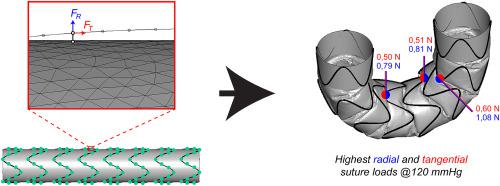Journal of the Mechanical Behavior of Biomedical Materials ( IF 3.3 ) Pub Date : 2020-06-26 , DOI: 10.1016/j.jmbbm.2020.103852 Misael Dalbosco 1 , Carlos Rodrigo de Mello Roesler 2 , Pierre Galvagni Silveira 3 , Eduardo Alberto Fancello 2

|
Second-generation stent-grafts (SGs) have addressed many of the mechanical problems reported for first-generation endoprostheses, such as graft tear and stent rupture; however, suture wear and detachment due to pulsatile fatigue remains an issue. Numerical studies on the mechanical behavior of these endoprostheses usually model the attachment between stents and graft as a continuous ‘‘tie’’ constraint, which does not provide information on the mechanical loads acting on individual sutures. This paper presents a suitable approach for Finite Element (FE) simulations of SGs which allows for a qualitative evaluation of the loads acting on sutures. Attachment between stents and graft is modeled as rigid beams at discrete locations of the endoprostheses, and the reaction forces on the beams are analyzed. This modeling strategy is employed for four different SG models (two Z-stented commercial models and two circular-stented models) subjected to a severe 180° U-bend, followed by intraluminal pressurization. Results show that, for all models, the majority of sutures is experiencing fluctuating forces within a cardiac cycle (between 80 and 120 mmHg), which points to pulsatile fatigue as potential failure mode. In addition, the highest loads are concentrated in kinks and, for Z-stented models, at the apexes of stents. Moreover, suture loads for circular-stented models are lower than for Z-stented models, indicating better resistance to suture detachment. All these observations are in line with experimental results published in the literature, and, therefore, the procedure herein proposed may serve as a valuable tool in the development of new SG models with better suture resistance to pulsatile wear and fatigue.
中文翻译:

支架形状对支架移植物缝合力影响的数值研究。
第二代覆膜支架(SGs)解决了第一代内置假肢所报告的许多机械问题,例如移植物撕裂和支架破裂。然而,由于脉动性疲劳造成的缝线磨损和脱落仍然是一个问题。这些内置假体的机械行为的数值研究通常将支架和移植物之间的连接建模为连续的“约束”约束,而这种约束并不提供有关作用于单个缝合线上的机械载荷的信息。本文为SG的有限元(FE)仿真提供了一种合适的方法,该方法可以对缝合线上的载荷进行定性评估。将支架和移植物之间的附着建模为内置假体离散位置处的刚性梁,并分析在梁上的反作用力。这种建模策略适用于经受180°严重U型弯曲并随后进行腔内加压的四个不同的SG模型(两个Z型支架商业模型和两个圆形支架模型)。结果表明,对于所有模型,大多数缝合线都在心动周期(80至120 mmHg之间)内承受波动力,这表明脉动疲劳是潜在的失效模式。此外,最大的载荷集中在扭结上,对于Z形支架模型,最大载荷集中在支架的顶端。此外,圆形支架模型的缝合线负载比Z支架模型的缝合线负载低,表明对缝合线分离的抵抗力更高。所有这些观察结果均与文献中发表的实验结果一致,因此,











































 京公网安备 11010802027423号
京公网安备 11010802027423号